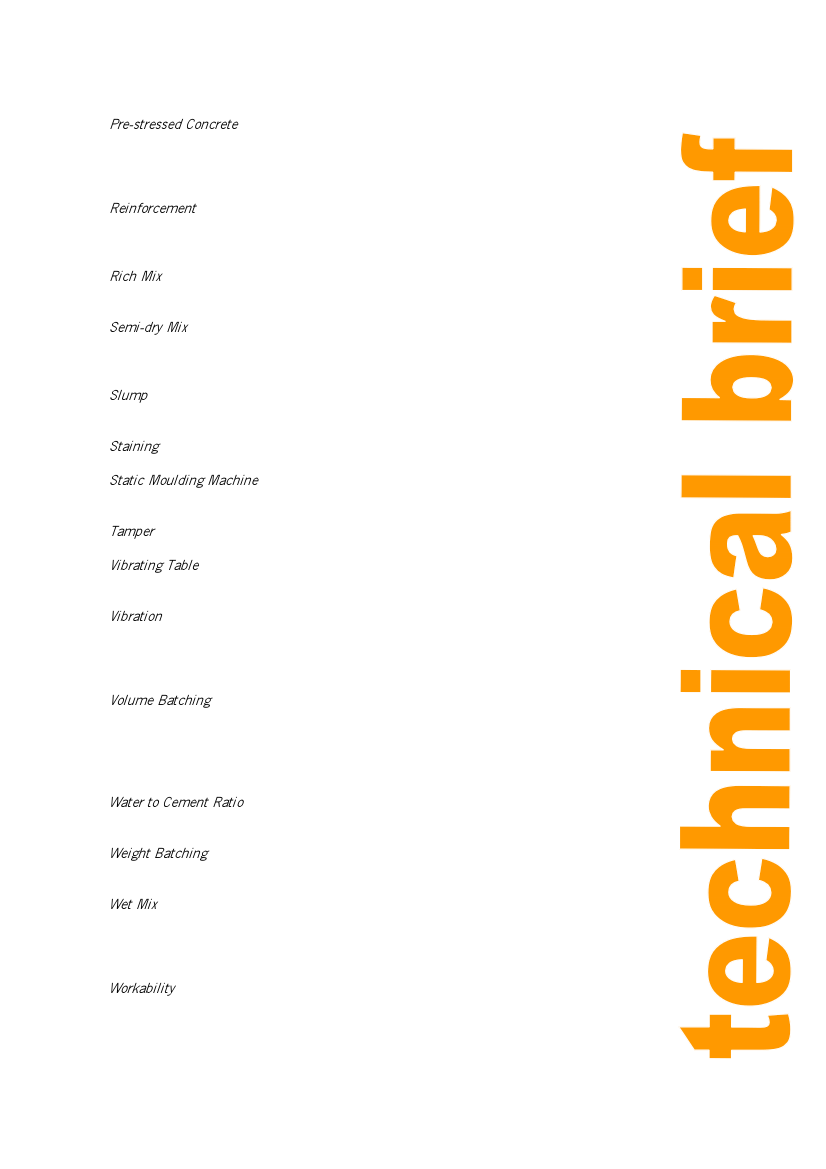
Introduction to concrete building products
Practical Action
where they are needed for building.
• Pre-stressed Concrete - A method of construction often used for beams heavily loaded in
tension or flexure. The steel reinforcement rods in the beam are first stretched and the
concrete then cast around them. When the concrete has hardened the tension is released
so that, in effect, the concrete is permanently under compression in the beam. Care needs
to be taken when demolishing buildings containing pre-stressed elements.
• Reinforcement - Concrete is weak in tension and flexure and to resist these types of forces
reinforcement often needs to be provided. The reinforcement is often steel, which is
strong in tension and flexure, although other materials such as a plastic mesh and fibres
such as sisal or glass have also been used in certain applications.
• Rich Mix - A concrete mix which contains a high proportion of cement. This mix will be
costly but it will also have high strength. Rich mixes are generally used for thin sections,
such as tiles, and hard-wearing surfaces, such as floors.
• Semi-dry Mix - A concrete mix which contains a relatively small amount of water but,
nevertheless, sufficient to allow it to be moulded without application of a very high amount
of pressure. Concrete blocks, made with a semi-dry mix, can be demoulded immediately
after forming and will be freestanding without slumping.
• Slump - When a wet concrete shape is taken from its mould immediately after casting it
will usually collapse, or slump, partially or wholly. The extent by which it slumps is a
measure of the wetness of the mix and can be used as a quality control test.
• Staining – another term for adding pigments or colouring agents to concrete to give
coloured concrete products.
• Static Moulding Machine - This type of machine is not mobile, unlike the egglaying
machine. Concrete products are usually deposited by the machine on pallets which are
then taken away for curing.
• Tamper - A heavy tool with a flat base used to consolidate concrete in the mould by lifting,
dropping and pressure. It is often applied manually in small-scale production.
• Vibrating Table - A flat metal surface suspended on dampers which has a vibration unit
attached to it. Moulds with concrete are put on the table to vibrate them and consolidate
the concrete.
• Vibration - A wet concrete mix will contain many small air bubbles which will lead to low
strength and inconsistent quality of concrete products. Vibrating the concrete will remove
some of the air bubbles and give a stronger and more durable concrete when hardened.
Excessive vibration, however, is not advised because it will lead to separation out of the
cement, water and aggregate fractions.
• Volume Batching - This is the process of measuring out quantities of materials by volume.
Batching boxes may be used to provide the required volumes of cement, sand and coarse
aggregate. Volume batching is not recommended for the concrete products yard. Weight
batching is more accurate and gives more consistent products with less wastage of
materials. Volume batching may be acceptable for on-site mixing in small construction
jobs.
• Water to Cement Ratio - This is the weight ratio of water to cement used in a concrete mix.
It is related to the compressive strength of concrete by Abrams law and is an important
factor in concrete mix design.
• Weight Batching - This is the process of batching out raw materials for concrete production
by weight. It is considered to be more accurate than volume batching, but is often
impractical at a small building site.
• Wet Mix - A concrete mix with substantial water added to make it easy to mould and to fill
out corners and edges of moulds. Increasing the water content will make a mix more
workable but reduce the compressive strength of the concrete, so a compromise often
needs to be chosen. The wetter the mix the higher the slump value given by the slump
test, and this test is effective in gauging the wetness of a mix.
• Workability - Workability is a measure of how easy or difficult it is to make a concrete mix
flow and take up the shape of a mould. The higher the water to cement ratio for a given
mix, the higher the workability would be but the lower the compressive strength of the
hardened concrete.
26